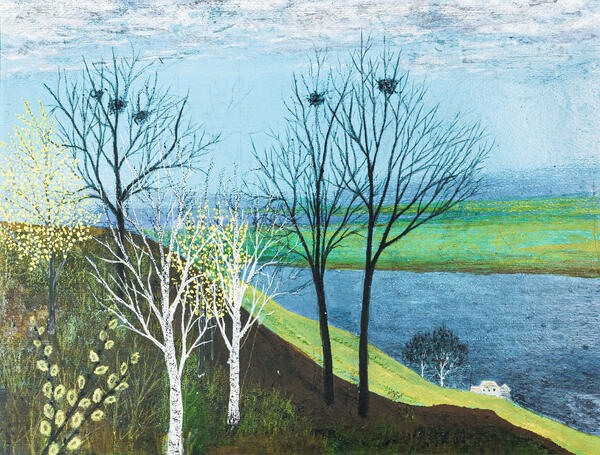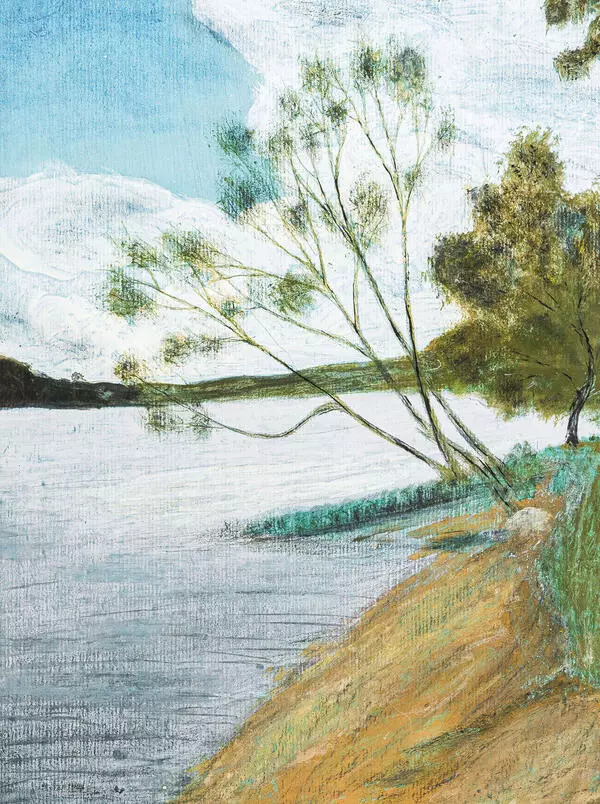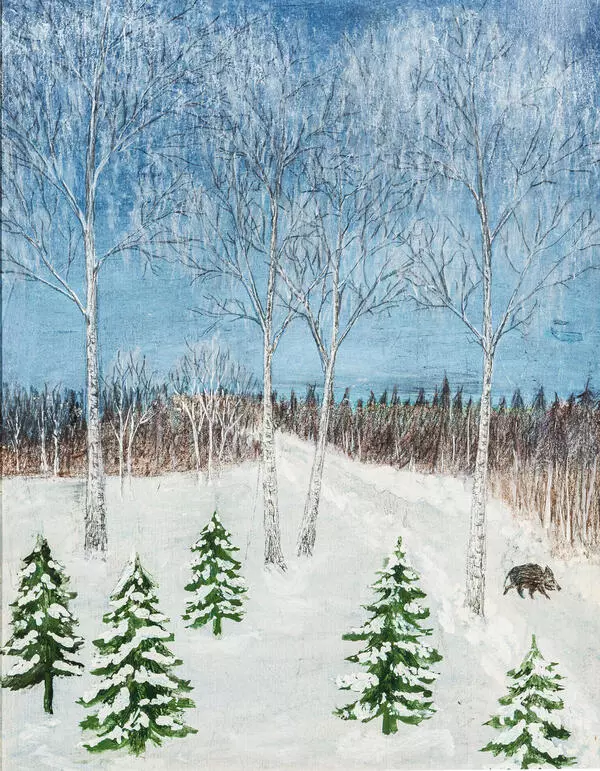Many paintings by the naive artist Alexandra Utkina, which are in the collection of the Museum Center, depict rocky shores, wild forests, forest edges, and animal trails. The landscape remains the artist’s favorite genre.
In some works, Alexandra Iosifovna uses a combination of techniques. She combines oil with watercolor or gouache and makes pencil strokes on top of the painting layer. Sometimes she gently scratches the surface of the paint layer, exposing the primer or the texture of the cardboard.
The artist Alexandra Utkina dedicated ‘Landscape with Willow’ to nature’s awakening from overwintering. She depicted a steep bank, a small house standing by the river, white and gray clouds drifting in the sky, and the horizon covered with a bluish fog.
She violates the rules of perspective in the painting. This is a traditional technique of naive artists. Despite the fact that the house is located in the middle ground, it is small as if were in the background, on the other side of the river.
The artist accurately depicted the transitional state of nature, when the river was not frozen any longer, the fields were covered with the first light green grass, but the trees were still black with bare branches. The bright shades and the combination of contrasting colors — such as bright blue, deep brown, yellowish-green — enhance the mood of anxious expectation in the painting.
Green leaves have already begun to appear on the birches, and the willow branch is thick with fluffy buds.
The willow usually grows in damp places like on the banks of rivers and lakes, sometimes near swamps. Willow is associated with one of the most important Orthodox holidays called Palm Sunday (‘Willow Sunday’ in Russian).
According to legend, Jesus Christ and his disciples were on their way from Bethany to Jerusalem to celebrate Easter. When Jesus entered the city, many Jews already knew about the miraculous resurrection of Lazarus. The people greeted Jesus with palm branches and hosanna — a short exclamation expressing praise, which was usually used at the end of the prayers. In the Slavic tradition, palm branches were replaced by young willow twigs. They were collected on the eve of Palm Sunday on Lazarus Saturday. During the holiday believers blessed them in the church and after they were kept at home all year round.
In some works, Alexandra Iosifovna uses a combination of techniques. She combines oil with watercolor or gouache and makes pencil strokes on top of the painting layer. Sometimes she gently scratches the surface of the paint layer, exposing the primer or the texture of the cardboard.
The artist Alexandra Utkina dedicated ‘Landscape with Willow’ to nature’s awakening from overwintering. She depicted a steep bank, a small house standing by the river, white and gray clouds drifting in the sky, and the horizon covered with a bluish fog.
She violates the rules of perspective in the painting. This is a traditional technique of naive artists. Despite the fact that the house is located in the middle ground, it is small as if were in the background, on the other side of the river.
The artist accurately depicted the transitional state of nature, when the river was not frozen any longer, the fields were covered with the first light green grass, but the trees were still black with bare branches. The bright shades and the combination of contrasting colors — such as bright blue, deep brown, yellowish-green — enhance the mood of anxious expectation in the painting.
Green leaves have already begun to appear on the birches, and the willow branch is thick with fluffy buds.
The willow usually grows in damp places like on the banks of rivers and lakes, sometimes near swamps. Willow is associated with one of the most important Orthodox holidays called Palm Sunday (‘Willow Sunday’ in Russian).
According to legend, Jesus Christ and his disciples were on their way from Bethany to Jerusalem to celebrate Easter. When Jesus entered the city, many Jews already knew about the miraculous resurrection of Lazarus. The people greeted Jesus with palm branches and hosanna — a short exclamation expressing praise, which was usually used at the end of the prayers. In the Slavic tradition, palm branches were replaced by young willow twigs. They were collected on the eve of Palm Sunday on Lazarus Saturday. During the holiday believers blessed them in the church and after they were kept at home all year round.







